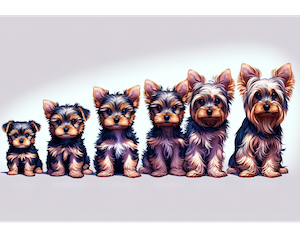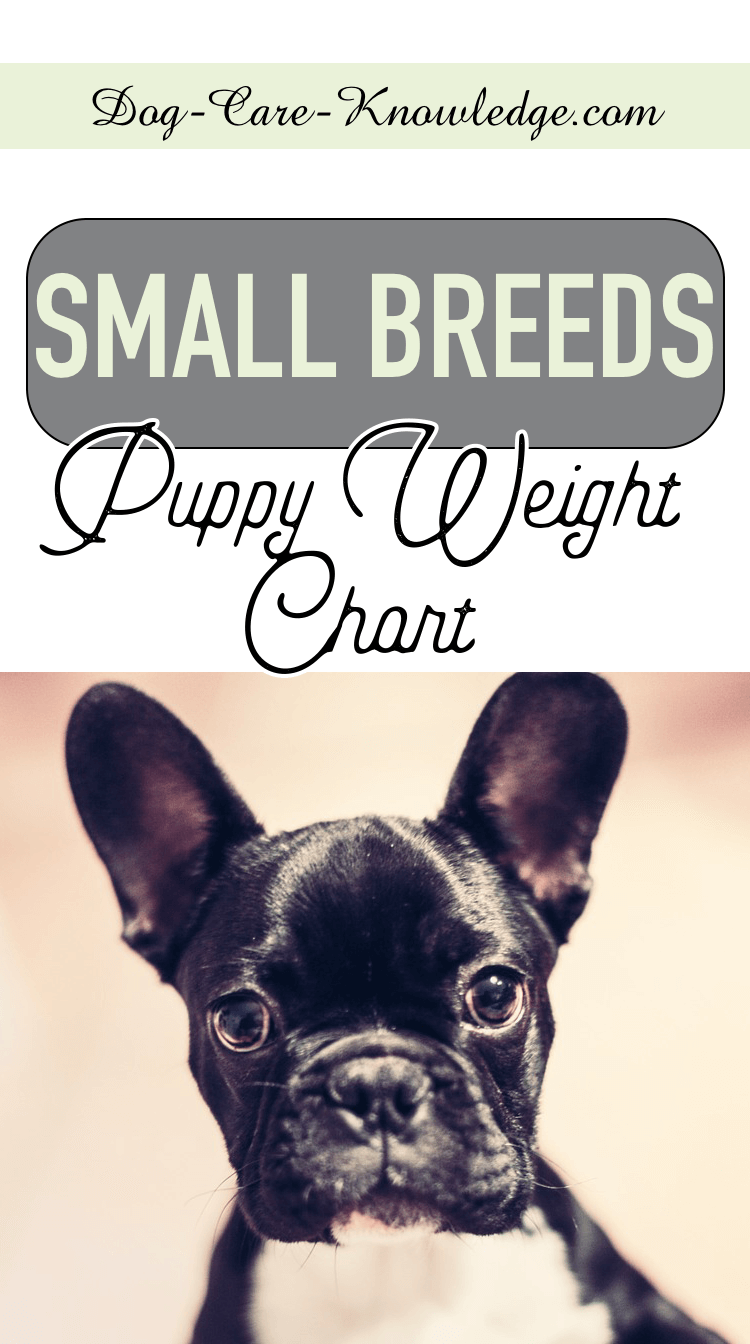- Home
- Dog Weights
- Puppy Weight Chart
Puppy Weight Chart By Age -
For Each Breed Size Category
A puppy weight chart can help you estimate how big that cute little bundle of fur is going to be when full grown.
However, it's not one size fits all, and is often dependent on breed size. So, if you're asking yourself just how big will my pup get? These puppy weight charts will give you a good idea. Plus, they will enable you to monitor their health and growth.
Are you worried that your puppy is growing at an alarming rate?
Or, do you want to know how big your puppy will get when fully grown?
If so, here's a puppy weight chart for each breed size category that answers the questions, "how big will my dog get?" and "how to calculate my puppy's weight?"
You'll also get an idea of how much weight, on average, a puppy gains each week as well as what weight to expect at each milestone.
Puppy Weight Charts
By using these charts you'll know exactly what to expect as they grow up. It's something I wish I had when I had my first pup.
When my dog, Hudson, was a puppy, he grew at what I thought was an alarming rate during the first six months. Turns out it's normal for German shepherds, especially as he was a big boy. His growth did start to slow after that time but I would have liked some information to compare to.
Puppy Size Categories
Generally, most puppies fit into one of the five breed sizes; toy, small, medium, large, and giant. However, there is occasionally some overlap between the categories.
Below are the usual weights by size:
- Toy = up to 12 lbs
- Small = 12 - 25 lbs
- Medium = 25 - 50 lbs
- Large = 50 - 100 lbs
- Giant = Over 100 lbs

Puppy Weight Calculator
You can also use our puppy weight calculator to estimate the adult weight of your puppy. This interactive tool is different from most as it is based on breed size. It uses the growth rate of breed size to predict the adult weight. Why not give it a try?
How to Use a Puppy Weight Calculator
Using the puppy weight calculator in 4 easy steps:
- Click on our interactive tool
- Enter your puppy's age
- Enter your puppy's current weight
- Enter breed size (according to above chart)
The tool will then give you an estimate of what your puppy will likely weigh when fully grown. Simple!
Toy Breeds
Let's start with the little guys out there, the toy breeds.
Toy breeds include, but are not limited to:
- Chihuahua
- Chinese Crested
- Maltese
- Papillon
- Pekingese
- Pomeranian
- Shih Tzu
- Yorkshire Terrier

- Toy breeds, on average, gain about 5 - 10% of their body weight daily.
- Roughly between 1 - 5 oz per week.
- These tiny cuties grow much faster than larger dogs and usually achieve their adult weight by eight or nine months of age.

Below is a chart that calculates how big your toy puppy will grow depending on their birth weight.
Puppy Weight Chart - Toy Breed
If you don't know your puppy's birth weight, you can still calculate his adult weight. Find his age (down the left column) and the nearest corresponding weight at that age. Next, go down that column to see what he will weigh as an adult or at every milestone along the way.
For instance, If you have a 12-week-old puppy that weighs 24 ounces (1.5 lbs), then the closest to that is between 22 ounces (1.38 lbs) and 26 ounces (1.63 lbs), which means your pup probably weighed between 3 - 3.5 ounces at birth and will weigh between 3 - 3.5 lbs when fully grown.

- To convert ounces to lbs: 1 ounce = 0.0625 lbs (16 ounces in 1lbs)
- To convert ounces to kg: 1 ounce = 0.0283 kg (35.274 ounces in 1 kg)
Small Breeds
Small dogs typically grow faster than large dogs but not as quickly as the toy versions. They reach their adult weight between eight and twelve months.

Examples of breeds that are considered "small" are:
- King Charles Spaniel
- French Bulldog
- Jack Russell Terrier
- Pug
- Shetland Sheepdog
In general, this consists of breeds that are between 12 and 25 lbs.
However, there is some overlap with the toy breed size at the lower end of that scale and the medium-sized dogs at the higher end.
Small breeds tend to gain weight at a rate of 5-10% increase each day which equates to roughly 5-8 ounces per week.
You can use the above chart to determine how big your small puppy will get. Find the weight closest to your puppy's age and go down that column to see the age at 12 months. This will likely be close to his adult weight.
For instance, if you have a 16-week-old puppy that weighs 5 lbs, go down that column where you'll see he/she will be about 16.3 lbs when fully grown.
But, what do you do if your puppy's age (or weight) isn't on the chart? The simple answer is to find the average.

If your puppy weighs between two weights for his age, you can find the average of the two. For example, if your puppy is 5.5 lbs at 16 weeks, he will weigh between 16.3 and 19.5 lbs as an adult, or, to be more accurate, the average is 16.3 + 19.5 divided by 2 = 17.9 lbs as an adult.
Medium Breeds
Medium dogs typically reach 99% of their adult weight between nine and ten months of age.
In general, the medium category consists of breeds that are between 25 and 50 lbs.

There is some overlap between small breed size at the lower end of that scale and the large-size dogs at the higher end.
Medium breed dogs consist of, but are not limited to:
- Border Collie
- Bulldog
- Cocker Spaniel
- Corgi
- English Springer Spaniel
- Whippet
For a dog that is in the "medium" size category, you can use the below chart to determine how much your puppy will weigh when fully grown. You can also see how much he'll weigh at each milestone, such as 12-weeks,16-weeks, 6-months, 8-months and so on.
To use the chart, start with your puppy's age down the left side, then see where he falls based on his current weight. For example, if your pup is 12 weeks old and weighs 7.5 lbs, then follow that column down to the "12-month" row, which in this case is 32.5 lbs, and that'll be how much your pup will likely weigh as an adult.
If your puppy's age or weight isn't on the chart, don't worry, there are still a couple of things you can do to calculate his adult weight.

Calculating The Adult Weight of a Medium Breed Puppy
If your puppy is between two weights for his age then just find the average of the two, i.e. if your puppy is 7 lbs at 12 weeks he will be between 29.3 and 32.5 lbs as an adult or, to be more accurate, you can find the average which is 29.3 + 32.5 divided by 2 = 30.9 lbs as an adult.
If your puppy's age isn't on the chart do this to find his weight at a certain age.
If you don't mind a bit of math, there are a couple of other methods to determine your puppy's adult weight. I've outlined them on this page.
Puppy Weight Chart - Large Breed
Large breed dogs take at least a year or eighteen months to reach their full adult weight.
In general, the large breed category consists of breeds that are between 50 and 100 lbs, but there is some overlap with the medium breed size at the lower end of that scale and the giant size dogs at the higher end.
Large breed dogs consist of, but are not limited to:
- Alaskan Malamute
- Boxer
- Bloodhound
- Doberman Pinscher
- German Shepherd Dog
- Golden Retriever
- Labrador Retriever
To predict what your large breed puppy will weigh when fully grown, you can use the below chart to get a rough idea based on their current weight.
If you have a German Shepherd puppy, you can see our weight chart that is specific to the GSD breed here.
To use the chart, start with your puppy's age down the left side, then see where he falls based on his current weight. For example, if your pup is 16 weeks old and weighs 22 lbs, then follow that column down to the "12-month" row, which in this case is 71.5 lbs, which is what he'll weigh if he stops growing then.
If your puppy is in between two weights for his age, then find the average of the two.
Understanding the growth rates of large breed puppies is much different from smaller breeds. Many large breed dogs keep growing past the 12 month point, which is when smaller breeds usually stop.
Many large breeds continue to keep growing until they are 18 months old and more. If they do this, they could weigh over 100 lbs.
Puppy Weight Chart - Giant Breed
In general, the large breed category consists of breeds that are over 100 lbs, but there is some overlap with the large breed size at the lower end of the scale.
Large breed dogs consist of but are not limited to; Bernese Mountain Dog, Bullmastiff, Newfoundland, Saint Bernard, Great Dane, and Irish Wolfhound.
Generally, giant breed dogs take longer to reach their adult weight which is at least 12 - 18 months old. Giant breeds that are at the top end of the scale (i.e. Mastiffs, Great Danes, Newfoundlands, etc), may even continue to grow up to 2 or 3 years old!
These giant dogs typically gain 2 - 3 lbs per week, however, the big guys at the top of the scale (i.e. Newfoundlands) will gain about 3 - 5 lbs per week).
To predict what your giant breed puppy will weigh when fully grown, use the below chart to get a rough idea based on his current weight.
To use, start with your puppy's age down the left side, then see where he falls based on his current weight. For example, if your pup is 10 weeks old and weighs 25 lbs, then follow that column down to the "12 month" row, which in this case is 130 lbs, which is what he'll weigh if he stops growing then.
However, many giant breed dogs keep growing past 12 months, so may continue to keep growing until they are 18 months old or even 2 years old.
If your puppy is between two weights for his age, then find the average of the two.
What To Do If You Have a Mixed Breed Dog
If you have a mixed-breed dog, then it may feel like you're entirely in the dark about knowing, or even just guessing, how big your adorable mutt is going to be.

You could do this two ways. You could take a look at all the growth charts on this page and see where your little guy fits in best. Or if you want to be more precise, use a DNA test to see which breeds your puppy is mixed with. Then you'll know which puppy weight chart to use.
To Find Your Puppy's Weight at a Certain Age
If you're trying to use the chart to find your puppy's adult weight, but notice his weight isn't on there, it's possible to find out what he weighed at a certain age.
The easiest way is to look at your vet's record or receipt. We typically take our puppies to the vets between 8 - 16 weeks of age for their puppy shots. Your veterinarian will weigh your pup at that time and keep a record. His recorded weight will be on the receipt, or you can give them a call and ask!
Other Factors Influencing a Puppy's Growth
Although our weight charts are great for monitoring your pet's growth, keep in mind that many factors influence a puppy’s growth and weight.
These factors can potentially alter your puppy's growth curve, so it's important to consider them alongside any data in a chart.

The Impact of Spaying or Neutering on a Puppy's Growth and Weight
Firstly, spaying or neutering your puppy can have an impact on their growth and weight. Studies have shown that dogs that have been spayed or neutered often grow taller than their intact counterparts. The reason for this is that the removal of sex hormones (through spaying/neutering) can delay the time at which the growth plates close, leading to a longer period of growth.
Additionally, spayed or neutered dogs may have an increased risk of obesity. Hormonal changes can affect the pet's metabolism and appetite, potentially leading to increased food consumption and less energy expenditure. Therefore, special consideration should be given to diet and exercise routines for neutered or spayed dogs.
The Role of Genetics in Determining the Size of the Dog
Genetics plays a crucial role in determining a puppy's eventual size. Offspring will likely fall somewhere in the range between the sizes of their two parents. However, understanding the genetics behind a puppy's potential size can be complex since multiple genes are involved.
Besides, breed standards give a good indication of what weight and size a purebred puppy is likely to grow into, although there can still be significant variation between individual puppies in a breed. Mixed breed or mutt puppies can be especially difficult to predict in terms of final size, as they may have many different breeds in their genetic makeup.
Best Food For a Growing Puppy
The best food for a growing puppy is high-quality puppy food that is specifically formulated to meet the nutritional needs of young, developing dogs. Look for puppy food that contains essential nutrients such as protein, fat, carbohydrates, vitamins, and minerals.
It's important to choose a food that is appropriate for your puppy's size, breed, and age. Additionally, consulting with your breeder or veterinarian can help you determine the best diet plan for your growing puppy.
It’s very important to feed your dog the right type of dog food to ensure they grow at a normal rate. It's also important to feed your puppy at least three or four times a day to support his growing body.
Finally!
I hope these puppy weight charts, formulas, and puppy weight calculators, help you to understand better how big your puppy will be as a dog. But remember, all formulas and charts are based on average growth rates, but of course, all puppies and dogs grow at different rates. Most of them won't grow at the same consistent rate but will have little growth spurts along the way.
Toy and small breeds typically grow faster between birth and 11 weeks, and the large and giant puppies grow faster from birth to 5 months old. Medium-size dogs are somewhere in between the two!
Your smaller breeds of dogs will take less time to reach their adult weight, and larger dog breeds will take a longer length of time to grow fully.
It will take about 10 months for your small dogs to become adults. Larger dogs can take 1-3 years to grow fully.
These calculators are only a guideline and can’t cover the hundreds of breeds of dogs, or their variations. Some puppies will grow a bit slower, and some will grow a bit faster. Our charts serve as the ultimate dog growth guide by breed, helping you track your puppy’s development from tiny paws to full-grown adulthood.
Don’t worry too much about small differences between your puppy and the puppy weight chart, as long as they are happy and healthy.
It can be exciting to imagine how your little pup is going to turn into a significant member of your family. Be sure to take plenty of photographs and videos, to commemorate the process. In later years you can look back and remember when they were cute little pups.
If there seems to be something out of kilter, take your puppy to the vet for a check-up. There are medical conditions that can affect your puppy’s growth—too little or too much. Keep the puppy weight chart handy, so you know what to expect as your pup grows.
Like Our Puppy Weight Calculator?
You might like these too!
Reference/source:
Hawthorne, A. J., Booles, D., Nugent, P. A., Gettinby, G., & Wilkinson, J. (2004). Body-Weight Changes during Growth in Puppies of Different Breeds. The Journal of Nutrition,134(8), 2027S-2030S. doi:10.1093/jn/134.8.2027s













